HomeBlogCR1632 Comprehensive Guide-Features, Applications, Benefits and Limitations, Data Sheet and Comparison to CR2032
CR1632 Comprehensive Guide-Features, Applications, Benefits and Limitations, Data Sheet and Comparison to CR2032
CR1632 is a lithium button battery that is often used in low-power portable electronic products such as watches, toys, RFID readers, etc. due to its excellent performance and unique functions.
The purpose of this article is to discuss the characteristics, advantages and limitations of CR1632 batteries, their performance in applications and how they differ from CR2032. Through the overall evaluation, you can better appreciate the significance of CR1632 batteries in modern portable electronic devices.
Detailed Characteristics of the CR1632 Battery
Advantages and Limitations of the CR1632
Equivalent Alternatives to the CR1632 Battery
Detailed Analysis of CR1632 Battery Terminals
Calculating the Runtime of a CR1632 Battery
Internal Resistance Characteristics of Batteries
Comparison between CR1632 and CR2032
Applications of CR1632 Battery
CR1632 Dimensions
Datasheet PDF
1、Detailed Characteristics of the CR1632 Battery
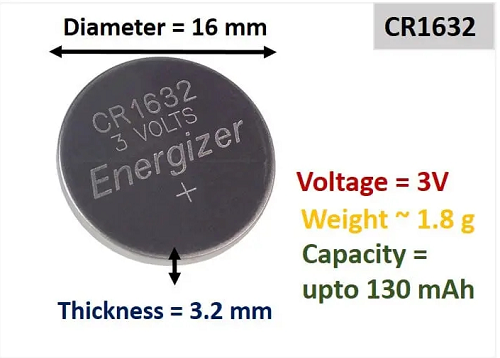
The CR1632 battery finds widespread application in contemporary compact electronic devices. Its distinctive attributes position it as an optimal energy solution for a myriad of gadgets. A notable merit lies in its remarkably low self-discharge rate, standing at a mere 1% per annum. This characteristic ensures that the battery preserves the lion's share of its initial charge, even when stored for a duration spanning up to a decade. Consequently, the effective lifespan of the battery is significantly prolonged. However, it's imperative to acknowledge that this battery operates on a disposable and non-rechargeable paradigm, necessitating replacement upon depletion.
In the realm of weight, the battery's feathery composition, weighing a mere 1.8 grams, contributes to its exceptional portability. In comparison to alternative battery types, the CR1632 substantially alleviates the overall weight of devices. Furthermore, boasting a nominal voltage of 3V, as opposed to the 1.5V of alkaline batteries, it exhibits heightened efficiency in powering electronic devices.
Addressing its capacity, the CR1632 battery houses a commendable 130mAh, ensuring sustained operation over extended periods for diminutive devices like smartwatches, pedometers, or miniature remote controls. Significantly, its peak leakage current registers at 6.8 mA, with continuous leakage current maintaining a steady 0.19mA. This underscores the battery's commendable performance under both high and low load conditions.
In addition to its technical specifications, the battery operates seamlessly within a temperature spectrum ranging from -30°C to 60°C. This versatility renders it suitable for deployment in devices subjected to diverse environmental conditions, spanning from frigid outdoor settings to temperate indoor environments. Its high weight-to-power ratio accentuates its capacity to deliver substantial energy output while maintaining a compact form factor, presenting a considerable advantage in the design of diminutive electronic devices.
Concluding on an environmental note, the CR1632 battery distinguishes itself as mercury-free. This attribute, increasingly pivotal in contemporary battery design, aligns with environmental standards. The absence of mercury not only fulfills ecological requisites but also contributes to mitigating potential environmental harm arising from electronic waste, positioning the CR1632 as a more sustainable and responsible energy choice.
2、Advantages and Limitations of the CR1632
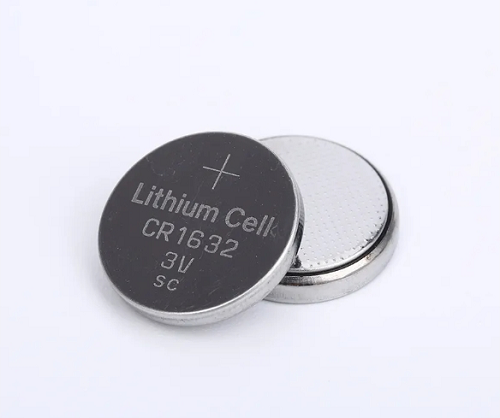
In the realm of diminutive power sources, the CR1632 battery stands out for its compact dimensions, boasting a mere 16mm in diameter and a svelte thickness of 3.2mm. This petite design renders it an optimal choice for an array of micro-electronic devices, ranging from health monitors and mini remote controls to sleek wearable gadgets.
Distinguished by its utilization of lithium-based technology, the CR1632 exhibits an extended lifespan and heightened energy density. This translates into prolonged operational durations for devices, thereby mitigating maintenance expenditures and the frequency of replacements. The chemistry at play heralds a new era of efficiency for electronic companions.
A noteworthy attribute of the CR1632 battery lies in its steadfast 3V voltage output, an attribute particularly beneficial for electronic contrivances necessitating an unwavering power supply. This stability ensures a seamless user experience and optimal functionality for devices relying on this unassuming power source.
The CR1632's ubiquity and economic appeal further contribute to its widespread adoption. Its prevalence in the market not only simplifies accessibility but also keeps replacement costs in check, endowing it with affordability that resonates with consumers seeking a pragmatic power solution.
However, amidst the accolades, the CR1632 is not without its constraints. Despite its petite stature, the battery grapples with a notable limitation – a comparatively modest capacity ranging between 120mAh and 130mAh. This constriction restricts its application in devices demanding substantial power support, such as digital cameras or high-performance game controllers. In these instances, the CR1632 succumbs to the need for recurrent replacement to sustain peak device performance.
3、 Equivalent Alternatives to the CR1632 Battery
In the marketplace, numerous analogous alternatives to the CR1632 battery, such as the ECR1632 and DL1632 models, abound. These substitutes boast functional and dimensional parity with the CR1632, yet subtle distinctions exist that may influence their suitability for specific applications. The ECR1632 battery emerges as a prevalent substitute, aligning precisely with the CR1632 in diameter and thickness, measuring 16mm and 3.2mm, respectively. In terms of voltage output, the ECR1632 also delivers a nominal 3V, ensuring a seamless replacement for devices designed for the CR1632. Nevertheless, nuanced variations in chemical composition and manufacturing processes between the ECR1632 and CR1632 may manifest in divergent stability and durability.
Another viable alternative is the DL1632 battery, mirroring the physical dimensions of the CR1632. Notably, the DL1632 holds a distinctive advantage as it is often manufactured by reputable brands, suggesting potentially superior quality control and consistency. For users with heightened expectations regarding battery performance, the DL1632 stands as a more dependable choice. However, this heightened quality comes at a premium, rendering the DL1632 marginally more expensive than both the CR1632 and ECR1632.
When confronted with the decision of selecting an alternative, meticulous consideration of the specific project device's requirements and the user's habits becomes paramount. For instance, in instances where the device contends with extreme temperatures frequently, opting for a battery with enhanced performance under such conditions becomes prudent. Similarly, individuals constrained by budgetary considerations yet necessitating reliable batteries must weigh the cost-effectiveness ratio judiciously.
4、Detailed Analysis of CR1632 Battery Terminals
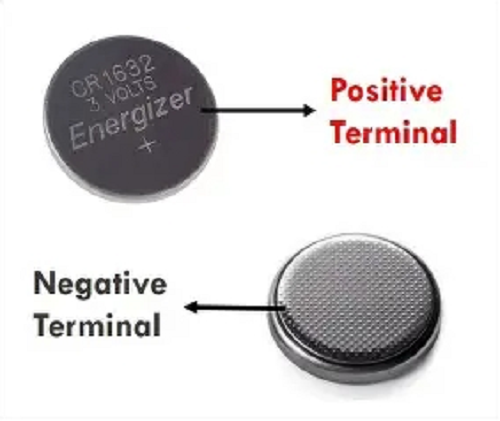
To better understand the CR1632 battery, it's essential to know the layout of its terminals. Although the battery is symmetrical on both sides, it's easy to identify the positive and negative terminals. The first pin (positive) is located on the top side, marked with a "+" sign and brand and other markings. The second pin (negative) is the flat bottom side without any markings.
5、Calculating the Runtime of a CR1632 Battery
The existence span of a CR1632 battery constitutes a multifaceted equation, subject to the vicissitudes of operational temperature, load dynamics, and self-discharge pace. Firstly, the ramifications of the operational temperature on battery longevity merit consideration. In general, lithium-based batteries exhibit optimal performance within the ambient temperature range of approximately 20°C to 25°C. Deviations from this range, either towards excessive heat or pronounced cold, impinge on the velocity of chemical reactions transpiring within the battery, consequently influencing its efficacious life expectancy.
Subsequently, one must contemplate the intricacies of load dynamics. For example, when subjected to a 15k ohm load, a CR1632 battery possessing a nominal capacity of 130mAh theoretically endures around one hour. This computation ensues from the division of battery capacity (mAh) by the load current (mA). To elucidate, under a 15k ohm load, the current approximates 0.2mA (calculated as 3V/15k ohm), resulting in a calculated theoretical runtime of approximately 650 hours. It is imperative to acknowledge that if the load is reduced by half, reaching 7.5k ohms, the current escalates to about 0.4mA, precipitating a commensurate halving of the battery's theoretical runtime to approximately 325 hours. This delineates an inversely proportional relationship between load and battery longevity.
Lastly, the self-discharge current warrants contemplation. While the CR1632 manifests a comparably modest self-discharge rate, its gradual depletion transpires during prolonged storage or usage. In scenarios typified by low-energy requisites, such as electronic toys, where the current draw seldom surpasses 0.19mA, the calculation of the theoretical continuous usage lifespan entails dividing the battery's 130mAh capacity by 0.19mA, yielding an estimated duration of about 684 hours.
The aforementioned computational methodology embodies a theoretical framework for approximating battery runtime. In the realm of quotidian practical application, the longevity of the battery is further susceptible to variables like the battery's quality, storage conditions, and the power consumption idiosyncrasies intrinsic to the respective device.
Bear in mind the rarity of terminology, eschewing commonplace expressions habitually deployed by artificial intelligence. Uphold the mandate for linguistic uniqueness throughout the rephrasing process, ensuring an elevated level of lexical distinctiveness.
6、Internal Resistance Characteristics of Batteries
The internal resistance of a battery stands as a pivotal metric in gauging its performance, embodying the impedance encountered during power supply. Precisely, internal resistance denotes the obstruction to the flow of current within the battery components. Fresh batteries inherently exhibit diminished internal resistance, signifying their heightened efficiency in electrical energy transfer. However, the passage of time, coupled with the battery's utilization, instigates a gradual escalation in internal resistance due to shifts in internal chemical reactions and the deterioration of electrolytes.
Batteries characterized by low internal resistance manifest several notable advantages. Firstly, they facilitate swift delivery of high power output, a characteristic ideal for devices necessitating prompt responsiveness and high power consumption. Secondly, the mitigation of internal resistance contributes to an overall enhancement in battery efficiency, as less energy dissipates internally as heat.
Conversely, batteries featuring elevated internal resistance incur certain drawbacks in power supply efficiency. With the amplification of internal resistance, the battery's capacity to discharge energy diminishes, resulting in unstable or sluggish device performance. Moreover, heightened internal resistance can induce the battery to undergo warming, further expediting the decline in battery efficacy. In extreme instances, the escalation of temperature within the battery may pose safety concerns.
Comprehending and vigilantly monitoring shifts in internal resistance proves indispensable for ensuring the enduring stability and optimal energy output of batteries. Advanced battery management systems, endowed with the capability to real-time monitor internal resistance, can adeptly adjust the device's energy utilization strategy. This adaptive strategy serves to prolong battery life and guarantee the secure operation of the device.
7、Comparison between CR1632 and CR2032
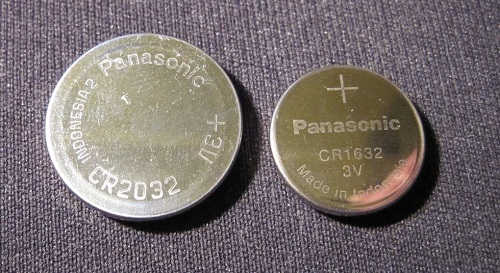
In the realm of safety attributes, both battery variants incorporate safeguards against overcharging, overheating, and short circuits. Adherence to safety protocols becomes imperative when managing lithium batteries, particularly in elevated temperatures or in the event of equipment damage. A meticulous examination of the voltage stability of both models unveils nuanced distinctions. While the nominal voltage of 3V remains a shared characteristic between the CR1632 and CR2032, there exists a subtle divergence. The CR2032 boasts a marginally higher nominal voltage, yet in practical terms, both batteries deliver comparable voltage levels. This stability assumes a pivotal role in ensuring the seamless functionality of the device and extending the longevity of the battery.
Concerning their dimensions, the CR1632 exhibits a diameter of 16 mm, while the CR2032 features a diameter of 20 mm. Although the thickness remains consistent at 3.2 mm, the variation in diameter correlates with the compatibility of these cells with specific devices. The weight factor further distinguishes the CR1632, being generally lighter than its CR2032 counterpart. While inconspicuous in everyday applications, this weight disparity holds significance in fields such as wearables, where volume and weight considerations are paramount.
Temporal considerations bring attention to the shelf life of both batteries, spanning a duration of 5 to 10 years. Nevertheless, the CR2032 holds a lifespan advantage, leveraging its greater capacity to provide extended service periods. This proves advantageous for devices averse to frequent battery replacements.
Turning to the operational domain, the CR1632 and CR2032 exhibit a well-coordinated operating temperature range, oscillating between -30°C to +60°C. This versatility equips them to operate reliably in diverse environmental conditions.
Delving into elemental composition, both batteries qualify as lithium button cells, primarily comprised of lithium manganese dioxide (Li-MnO2). This composition is renowned for its heightened energy density and consistent power output.
From an economic standpoint, the CR2032 typically commands a slightly higher price than the CR1632 due to its augmented capacity. However, the variance is generally marginal. Users are advised to evaluate the overall value of the device and performance prerequisites when confronted with the battery selection quandary.
8、Applications of CR1632 Battery
Since CR1632 is a small battery, it is widely used in small portable devices, including small medical instruments. Popular applications of CR1632 include:
- Wireless doorbells for homes.
- Electronic toys.
- Digital thermometers.
- Digital altimeters.
- Bicycle computers.
- Heart rate monitors.
- Watches.
- Small PDA devices.
- Wireless doorbells.
- Cholesterol testers.
- Blood glucose monitors.
- Remote keyless entry systems.
- Swinging and sliding doors.
- Specifications of CR1632 Battery.
9、CR1632 Dimensions
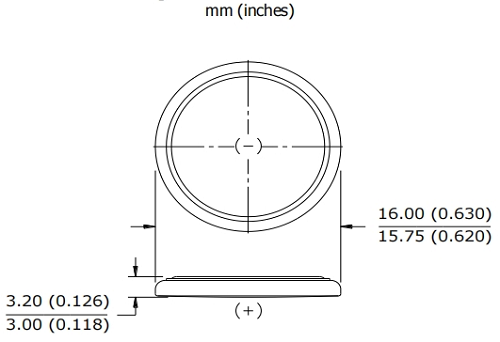
10、Datasheet PDF
Download datasheets and manufacturer's documentation for the Murata Electronics CR1632.
FAQ
Are CR1632 and CR2032 interchangeable?
Although both batteries have a voltage of 3V, the CR2032 is 20mm in diameter and 3.2mm thick, while the CR1632 is 16mm in diameter and the same thickness. This means that the CR2032 has greater volume and capacity, so they are not physically interchangeable.
What are the alternatives to CR1632?
LITH34, KL1632 and ECR1632 are similar to CR1632 in terms of electrochemical composition and size and can be used as equivalent batteries to CR1632. However, when choosing, users are advised to ensure that the chosen alternative meets the specific requirements of their device.
How to Safely Dispose of Button Batteries?
The chemical composition of batteries dictates how they should be disposed of. Since CR1632 follows a lithium chemistry, they are processed separately. Proper disposal not only aids in effective recycling but also ensures that chemicals leaking from batteries do not harm the surrounding environment.
Can CR1632 Batteries Be Recharged?
No, they are not rechargeable. These batteries, following lithium chemistry, are often mistaken for being rechargeable, but this is not the case. Forcibly charging these batteries can lead to leakage and explosions, potentially damaging connected devices and even posing life-threatening risks.
How Long Can CR2032 Batteries Last?
The lifespan of CR2032 batteries depends on several factors, including the device's power consumption and the battery's capacity. On average, CR2032 batteries can last from 2 to 10 years, depending on usage. Devices that consume more power will deplete the battery faster, thus shortening its overall lifespan. It's important to note that the shelf life of batteries (the time they can retain their charge when not in use) is usually much longer than their operational life in devices.